TV and Movies
-
When I initially published this post, I wrote the title as “The Milkman Always Rings Twice.” I don’t know whether that movie exists, but I would like to see it. It would be a steamy romance about an amorous milkman and a femme fatale who’s lactose intolerant. ↩︎
The secret history of Napoleon Bonaparte: Watching “The Emperor’s New Clothes” (2002) starring Ian Holm
We saw “The Emperor’s New Clothes,” an idiosyncratic and charming historical romantic-comedy that starred Ian Holm and came out in 2002.
I liked the movie a lot. It exceeded my expectations. I thought it would be more broad and farcical than it actually was. It had a big heart, which I did not expect.
The premise: Napoleon, in exile on the island of St. Helena after his defeat at Waterloo, executes a scheme to escape and be replaced on the island by a double, a common seaman who looks exactly like Napoleon, whose name is Eugene Lenormand. Napoleon will settle in Paris incognito, and the false Napoleon will reveal his true identity, as will the true Napoleon. France will rally and the empire will be restored.
But the plan goes wrong, and Napoleon needs to survive in Paris as Lenormand.
Fortunately for Napoleon, he’s taken in by a pretty widow.
But Napoleon never loses hope, and never stops planning to resume his rightful place as emperor.
Meawhile, he and the widow fall in love. She thinks he’s just Lenormand, a commoner like her, maybe someone who once did prison time.
Holm plays both Napoleon and the sailor Lenormand. He gives two great performances. As Napoleon, Holm is commanding, striding about erect with his hands clasped behind him. And he’s also sad and brave as he adjusts to life without the trappings and luxury of power.
In an early scene, Napoleon, disguised as Lenornmand, commands his ship’s captain to change course immediately and head for France. Holm’s performance is appropriately imperious, and you can easily imagine that underlings would be terrified to receive a command like that from the emperor. But now Napoleon is living the life of a common deckhand, and the ship’s captain just laughs at him.
Later, Napoleon marshals the same charisma to inspire rather than intimidate, and succeeds in rallying a band of struggling street vendors to sell fresh fruit.
Meanwhile, on St. Helena, the false Napoleon is enjoying his captivity. It’s a prison, but it’s posh and luxurious, with fine food, beautiful art and clothing, and servants to tend to Lenormand’s needs. In character as Lenormand, Holm is boorish, gluttonous, drunk and loud. His scenes are played for low comedy.
Iben Hjejle plays the widow, whom everybody calls “Pumpkin.” She’s a Danish actor, probably best known to American audiences for appearing as John Cusack’s girlfriend in “High Fidelity.” Pumpkin is your basic romantic-comedy woman’s role; she’s an auxiliary to the man. Her job is to look beautiful and adore Napoleon (whom she knows as Lenormand). Hjeile does the job. I’d like to see her in a real role sometime.
The magic of “The Emperor’s New Clothes” is that it commits to the bit. It takes its premise seriously.
As Roger Ebert noted in a 2002 review, you can easily imagine the movie going in a broad, Monty Python direction, but instead, “The Emperor’s New Clothes” is “a surprisingly sweet and gentle comedy.”
The dialogue and acting are first-rate, and the costumes and settings are up to the standards of any historical drama.
I was intrigued by “The Emperor’s New Clothes” because of a mention the movie got on the Age of Napoleon podcast, an extremely detailed history of the life and world of Napoleon, which has been running for seven years and isn’t anywhere near done. I’ve been listening to the podcast for several years.
The host, Everett Rummage, said he thought “The Emperor’s New Clothes” was the only movie that he ever saw that truly captured Napoleon’s character. This was before the current Ridley Scott movie came out.
Having now seen “The Emperor’s New Clothes,” I can absolutely see Rummage’s point. Granted, pretty much everything I know about Napoleon comes from Rummage’s podcast. But we know that Napoleon started as a minor nobleman in Corsica, went to French military school and quickly soared through the ranks during the Revolution. Napoleon was arrogant, but he also had a common touch. He was a democrat with a small “d,” unimpressed by aristocracy and valuing talent, character, and loyalty over inherited titles. He slept on the ground with his men in battle, gave them personal attention, and they loved him. We see all these qualities in “The Emperor’s New Clothes.” When the fictional Napoleon is required to scrub decks, sleep in a barn and rub elbows with street vendors, well, we can imagine that Napoleon had experience with that kind of thing.
In reality, Napoleon was a genius. He was an enlightened ruler who swept aside the old order and instituted more egalitarian forms of government that are influential to this day. He nurtured science, scholarship and the arts.
And Napoleon was also a bloodthirsty murderer, tyrant and monster who bathed Europe in blood and re-instituted a regime of brutal slavery that Haiti still has not recovered from more than two centuries later.
We only see the good side of Napoleon in “The Emperor’s New Clothes.” His evil is dealt with in a single line of dialogue. Which is as it should be in this particular movie.
The movie is loosely based on a novel by Simon Ley, “The Death of Napoleon.” Writer Peter Hicks compares the two. Hicks says the book is “a sustained elegy on the wisdom of recognising the important things in life, such as love, happiness, modest success,” which are far more important than the “chimaeras of power and military glory.” The movie has the same theme. As Ebert says, Napoleon gradually realizes that “the best of all worlds may involve selling melons and embracing Pumpkin.”
In an afterword to a 2006 edition of the book, Leys said the movie “was both sad and funny: sad, because Napoleon was interpreted to perfection by an actor (Ian Holm) whose performance made me dream of what could have been achieved had the producer and director bothered to read the book."
Based on Hicks’s description, I think I would prefer the movie and I am not tempted to read the book.
P.S. Hugh Bonneville, who stars “Downton Abbey” as Robert Crawley, plays a supporting role in “The Emperor’s New Clothes.” I didn’t recognize him.
“You’ve got me? Who’s got you?!” Rewatching Christopher Reeve’s “Superman”

The 1978 “Superman,” starring Christopher Reeve, launched the superhero film genre as it exists today. We rewatched it recently, enjoyed it, and I recommend it.
However, the movie takes a painfully long time to get going.
”Superman” starts with pages turning on the 1938 Action Comics issue that launched the Superman character, narrated by a child’s voice-over. We did not remember this from seeing the movie previously. We wondered whether we had accidentally rented the wrong version of “Superman.” We had not. Onward.
Then we go to Krypton, where the movie creeps forward. We see Marlon Brando as Superman’s father, Jor-El, wearing white stunt hair and a turtleneck with the Superman logo in it.

I wish the phrase “phoning it in” was not a cliche so I could use to to describe Brando’s performance. He drones on and on, making one speech after another.
He’s concluding the prosecutor’s statement in the trial of three insurrectionists (ripped from the 2020s headlines!), who end up being sentenced to the Phantom Zone. I’m sure we won’t see these insurrectionists again—they won’t be any trouble and will not turn up in “Superman II.”
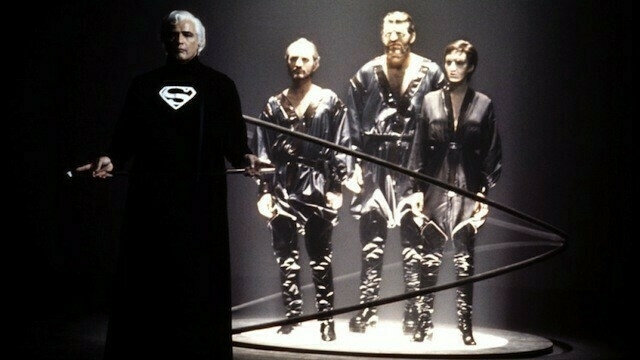
General Zod, played by Terence Stamp, is the leader of the trio, and his scenery-chewing is the only good part of this scene.
I saw “Superman” with friends in the theater during its first run in 1978, and I was very excited to tell them after the movie all about the Phantom Zone. I even guessed that the three villains would feature in the movie sequel. I was very proud of myself for this. Possibly related: It took me a long time to lose my virginity.
Jor-El warns the leadership council of Krypton that the whole planet is about to explode within a month. The leaders say this is fake news because they did their own research on YouTube. The council nopes out on evacuating the planet and tells Jor-El he can’t tell anybody about his beliefs or else he’ll be an insurrectionist (that word again). A sensible person would have told the council to fuck right off because the council was not going to have any clout after the ENTIRE FUCKING PLANET EXPLODES. But Jor-El just goes along with it.
Brando goes back home, where he and his wife (if her name is spoken, I didn’t hear it) put on matching glowy silver lamé jumpsuits. They put their baby in a spaceship. Before sending the baby off to Earth, Marlon Brando makes a very long speech, while his wife looks at him with an expression like she wants him to shut up because she needs to pee.
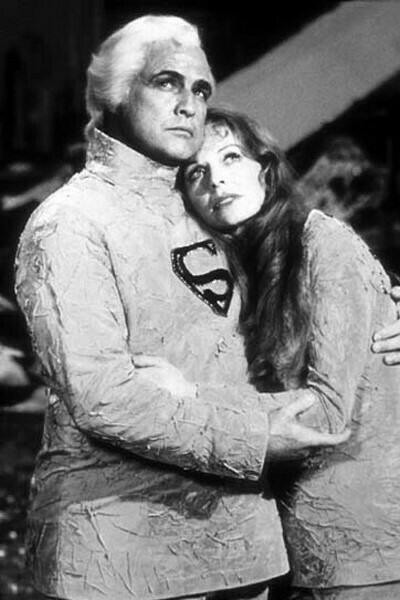
Then we’re off to Earth, to whip through young Clark Kent’s childhood. The costumes and cars and brilliant. The scenery from the Kent farm is beautiful, but there is way too much of it. Can we get this movie moving already?
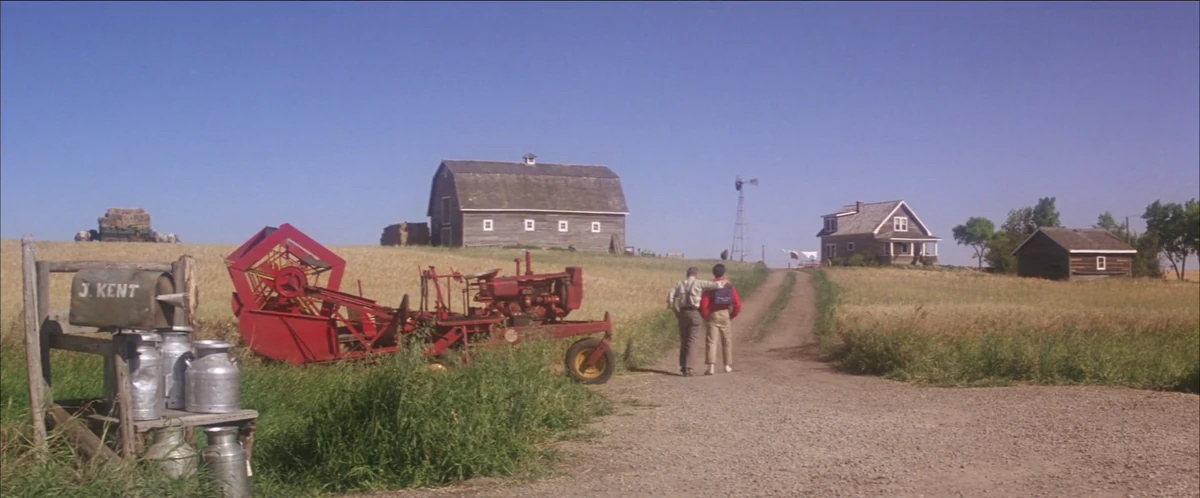
Clark challenges his father to run from the end of their driveway to the barn. Pa Kent has a heart attack and dies. Clark never mentions his own role in Pa’s death. That seems odd.
Next stop: the North Pole, where young Clark spends 12 years being lectured by the holographic Marlon Brando, and we, in the audience watching the movie, get to experience every painful second of those 12 years.
All this time, Clark is played by an actor who is not Christopher Reeve and doesn’t even look much like Christopher Reeve. This guy:
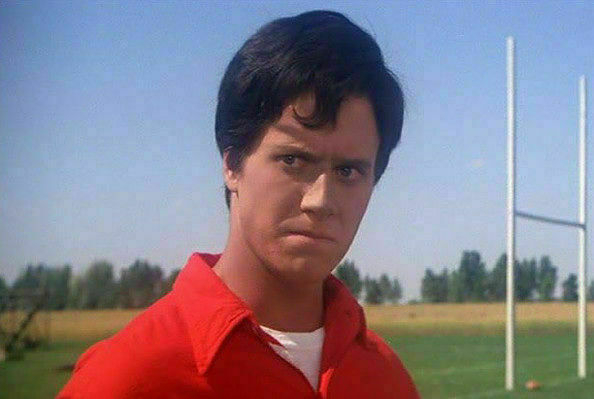
But after 12 years at the North Pole, demonstrating powers of super-boredom-resistance, Clark becomes Christopher Reeve and emerges in his spiffy super-suit, which makes all the girls swoon. He is a hunka hunka burnin love. The suit is very flattering, but he really should be wearing something modest below the waist and above the knee to better cover his prominent super-johnson. Maybe bermuda shorts with a festive luau pattern?
Or maybe something like this:

And we’re off to Metropolis and the movie takes off and keeps going. Finally! Lois Lane is fast-talking and smart; Christopher Reeve transforms from a nebbishy Clark into a charismatic Supe through the power of acting. Gene Hackman, Ned Beatty, and Valerie Perrine are the villains, and they chew the scenery delightfully. The sets are gorgeous, particularly Lex Luthor’s lair in the underground lobby of Grand Central Station. Why is Grand Central Station abandoned and apparently nearly forgotten in this movie? Does it even matter? No, it does not.
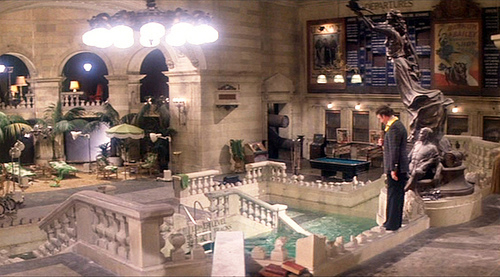
Lois’s costumes are the height of 70s couture. The first thing we see her in is a nice skirt and blouse. And the skirt has pockets. And they look like BIG pockets. In some ways, technology has gone backward since 1978.
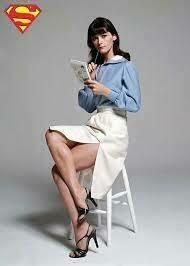
The Daily Planet newspaper takes up an entire skyscraper and has a helicopter to shuttle reporters around. I started work at a daily newspaper not long after “Superman” came out—we didn’t even have a budget to buy coffee for the staff. Employees had to pay for their own coffee.
Lois arranges an interview with Superman, which turns into a date. He flies her around the skies above Metropolis. She recites a love poem in her mind. The poem is painfully bad. It is like watching someone you like embarrass themselves in a talent competition.
We see a very neatly dressed and well-groomed mugger. Nice blazer, turtleneck sweater. He needs a closer shave, but we’re otherwise good.

It’s part of a whole sequence of Superman’s day’s work, as he stops a cat burglar heist, rescues Air Force One after it loses an engine, and rescues a little girl’s cat from a tree.
The ending of the movie, where Lois Lane dies (spoiler for a 45-year-old super-popular movie—don’t DM me!) is surprisingly dark. She’s smothered after being buried in an earthquake and we see all of it happening. But Superman quickly brings her back from the dead with his superpowers.
Superman’s flying SFX are every bit as good and dazzling now as they were in 1978. Oh, some of the matte shots with the New York City skyline in the background are a little fake, but Superman’s movements are brilliant. A one-second bit where Superman changes from his Clark street clothes into his superhero costume while in flight is just wonderful—nothing much today but brilliant in the pre-CGI era that this movie was made in. Some of the other special effects, like Hoover Dam disintegrating and a downstream town flooding, are a little obviously done with miniatures but they still look fine.
(Why do the sfx look fake now but not in 1978? I have a theory. In 1978, we saw these sfx on the big screen, where they looked great. They might still look great today on a big screen. Soon after, we saw the movie on smaller TVs, with lower quality screens than today, and the sfx still looked great. But today’s high-quality TVs make the sfx look fake—the screens aren’t big enough to compensate for the flaws revealed by the high definition.)
The movie can’t decide if it’s a camp superhero parody, or a serious superhero movie. It would have been better if it toned down the broad comedy and made Lex Luthor more scary.
Reeve’s acting carries the movie. There’s a scene that’s famous among fans where Lois Lane and Clark Kent are in the living room of her apartment. She leaves the room, and he decides to tell her he’s Superman. Until that moment, he’s a shlub, round-shouldered and with a goofy expression on his face. He stands up straight, squares his shoulders and jaw and takes off his glasses—and now he’s Superman. He starts to tell her. His voice as Clark is querulous and shaky, but Superman has a firm baritone. And he changes his mind, slumps his shoulders, puts on his glasses and now he’s Clark the shlemiel again. It all goes by in a few seconds, but it’s striking.
Even the special effects are carried by Reeve’s acting. “You will believe a man can fly,” was the marketing slogan for the movie when it was released. You believe it in large part because Reeve was hanging from wires, moving like a person flying. Acting.
I don’t have anything to say about John Williams’ musical score for the movie, except that it’s brilliant. I’m going to carry a Bluetooth speaker with me and play that score every time I enter a room.
Overall, well worth a watch. Maybe skip the first 48 minutes though. You don’t need to see it. You already know Superman’s original story.
Superman is my favorite superhero. He is optimistic and hopeful. He knows there is great evil in the world, but he knows that there is also great good, and he serves that good—“truth, justice and the American way." He knows some of what he says is corny and he says it anyway because he believes it. He is nearly all-powerful and invulnerable, but he is in awe of human beings because we are neither of those things, and yet we are capable of great kindness, nobility, and courage.
Sloppy Internet research
Four-year-old Clark Kent is played by an actor named Aaron Smolinski, who went on to a bit role in the 2013 Superman movie “Man of Steel” and also played Lex Luthor in a movie called “Superman: Solar,” which seems to be either an indy or fan-made Superman movie that got terrible reviews.
Larry Hagman has a cameo as an Army Major, making a joke that doesn’t age well.
John Ratzenberger plays an air traffic controller. He went on to play Cliff from “Cheers,” and do a lot of voice-overs for Pixar movies.
Kirk Allyn, who played Superman in 1940s Superman movies, has a cameo as Lois Lane’s father. When Clark is a boy in Smallville, little girl Lois sees Clark while passing through on a train, and Allyn appears in that scene. via
Noel Neill, who played Lois Lane in 1940s movies and the 1950s Superman TV series, also has a cameo. She’s Lois Lane’s mother in the same scene. via
“According to Sir Roger Moore’s autobiography, he witnessed Christopher Reeve walking through the canteen at Pinewood Studios in full Superman costume, oblivious to the swooning female admirers he left in his wake. When he did the same thing dressed as Clark Kent, no one paid any attention.” via
The Incomparable Mothership podcast did an episode about their “Superman” rewatch. They hated it. I don’t disagree with their criticisms, but for me, the virtues of the movie made up for its flaws. I enjoyed listening to the episode.
What happened to the actors
Marlon Brando continued working until his death in 2004. “Apocalypse Now” came out soon after “Superman.” His work in later life included two movies I quite enjoyed: “The Freshman” and “Don Juan DeMarco,” both of which are about charismatic rogues (though he only played the rogue in one of those movies). Brando also features in a delightful 2009 novel, “Chronic City,” by Jonathan Lethem, which explores the theme of whether we can believe anything or truly perceive reality. Brando isn’t a character in the novel. The characters can’t agree whether Brando is alive or dead, and the Internet is no help.
Margot Kidder struggled with mental health in later life. Her 2018 death was ruled a suicide. via
As of April 2023, Valerie Perrine, age 79, was suffering from advanced Parkinson’s and needed a hydraulic lift to get into and out of bed. The Hollywood Reporter did an excellent profile—recommended reading: Ailing ‘Superman’ Star Valerie Perrine Finally Finds Her Hero: “The Guy Should Be Sainted”:
Perrine insists she wants no pity and regrets nothing about her Technicolor life: not one affair (she’s been romantically linked to everyone from Jeff Bridges to Elliott Gould to Dodi Fayed); not one hit of acid (she’s taken LSD more than 400 times, by her estimation); not one career move (well, she probably should have said yes to 1981’s Body Heat and no to 1980’s Can’t Stop the Music, the Village People-starring megaflop she says killed her career, but you can’t win them all).
She sounds fantastic.
Gene Hackman has been retired for about 20 years. As of March, he was fit and healthy at age 93, spotted doing yardwork, buying and eating fast food, and pumping his own gas.
Christopher Reeve died in 2004, after being paralyzed in 1995 in a horse-riding accident.
Terence “General Zod” Stamp was one of the stars of “Priscilla, Queen of the Desert.” He played a drag queen named Bernadette.
Sarah Douglas, who played Ursa, one of General Zod’s cronies, appeared in a lot of B science fiction movies and TV shows, including one called “Strippers vs. Werewolves.”
Which Superman II?
We want to watch Superman II, which I remember as being even better than the first Superman, which was itself great. But which version?
Richard Donner directed the original movie and started directing on Superman II, but was fired, and Richard Lester was hired as a replacement. Donner had already done a lot of work, and Lester reshot many scenes and shot more. The Lester version was the original theatrical release, which I saw in theaters. We saw a fan cut of the Donner version in the early 2000s and did not care for it. It was unfinished. Some of the scenes were audition scenes; I remember some other scenes had cheap SFX that looked like they’d been done on 1990s home PCs.
Soon after we saw the fan cut of the Donner version, an official—and presumably more polished—version was released. We haven’t seen that.
I think when we do a rewatch, we’ll go with the original, theatrical version, directed by Lester. According to Internet discussion—for example, here—the official Donner version, while more polished than the fan cut we watched, is still unpolished and unfinished. And the theatrical version is lighter than the Donner version, while still having some serious moments. Generally, I like my superhero movies light; when they get dramatic and heavy I start having difficulty suspending disbelief.
On a private community, someone said they’ve just started watching “Babylon 5” on Season 2, and they want to know whether the show stays good.
I replied:
My memory of B5 is that the first season was wooden but there was something about it that made me stay with it. Seasons two through four were excellent.
As for the fifth season: As I recall, the series was initially supposed to go five seasons, but the showrunner, J. Michael Straczynski, got the word that the show would be canceled after four seasons. So he rushed Season 5 to an ending a half-season early.
Then JMS was told whoops, never mind, you get another half-season.
And that’s the way it looked to me onscreen—the first half of the first season was rushed and talky, as JMS was telling viewers information he would have shown if he had the proper amount of time.
Then the second half was just padding and bloviation. A main storyline involved a beautiful woman telepath falling in love with a male cult leader. He had Fabio hair. It just didn’t work for me.
For me, a lot of the fun of Babylon 5 was going on the Lurker’s Guide to Babylon 5 website the morning after each episode aired to see what little easter eggs and plot tricks were hidden in each episode. The website is still online, so somebody just watching the show can have the same fun.
We started a rewatch not long ago, but it didn’t work for either of us. Maybe if we’d started with the second season we would have liked it more?
A spinoff series, “Crusade,” had Gary Cole, which is a plus in any TV show or movie. He played a heroic starship captain. It would have been EVEN BETTER if he’d done the whole thing as Lundberg, his character from “Office Space,” with the contrasting-collar shirt, suspenders, coffee cup, glasses and “Yeah, I’m going to need you to go ahead and… “
I did not love the series but I liked the mix of epic fantasy and space opera. Which I guess is a common trope but not one I’ve encountered before or since.
I do remember one gag I quite liked from that series: a character is a member of the secret Thieves Guild, and this becomes important to the story. Gary Cole confronts her and demands to know why she never told him this. And she rolls her eyes and says, “What’s the point of being a member of secret society if you go around TELLING people about it?” As I recall, the character who was a member of the thieves guild wore a sexy catsuit but her manner was pure Gen X slacker, like Daria Morgendorffer in spaaaaaaace.
Ars Technica rates 20 time travel movies by entertainment and scientific plausibility.
What modern science has to say about time travel can be summed up thusly: You can travel to the future, but you probably can’t travel to the past, although to be honest, we’re not really sure.
Their list includes a personal favorite of mine: “Time After Time” (1979), starring Malcolm McDowell as time-traveling H.G. Wells, Mary Steenburgen as his plucky feminist 1970s galpal and David Warner as Jack the Ripper.
The IMDB trivia page for “Time After Time” does not disappoint.
All four of the real H.G. Wells’ children were still alive at the time of this film’s release.
…
Malcolm McDowell listened to recordings of H.G. Wells to prepare for the role. According to him, Wells’ voice was high-pitched and Cockney-accented, so he decided not to imitate
…
The movie’s title inspired Cyndi Lauper’s song “Time After Time”, when in 1983 she browsed through a copy of TV Guide for “imaginary song titles”.
…
A deleted scene featured Wells meeting a punk who was playing extremely loud boom-box music on a bus in San Francisco. [Director] Nicholas Meyer later reused this idea in Star Trek IV: The Voyage Home (1986).
Much of the action of “Time After Time” takes place in the Hyatt Regency San Francisco, as do a few scenes in Mel Brooks’ “High Anxiety.” I stayed in the same hotel in 2017; it hadn’t changed much, other than becoming deliciously dark and gloomy. A monument to 70s futurism.
One quibble with the Ars Technica list. Authors Jennifer Ouellette and Sean M. Carroll rightly praise the first Christoper Reeve “Superman,” including Gene Hackman’s “marvelous selection of outrageous wigs,” but add:
We’re knocking off a point for the cheesy “Read My Mind” spoken song as Superman takes Lois Lane (Margot Kidder) on a romantic flight over Metropolis, which has aged poorly.
No, that scene did not “age poorly.” It was always terrible. It was cringe in 1978 and it is cringe today.
Now I want to see “Superman” again, to enjoy Hackman, Ned Beatty and Valerie Perrine hamming it up as villains.
“Elf” + “Enchanted” = “Noelle”
The premise of the movie “Noelle” is that Santa Claus is a family business, with each Santa passing the pom-pom to his son. A few months ago, the last Santa died, and the responsibilty to pilot the sleigh falls on son Nick, who doesn’t want to do it and is terrible at it. Nick’s sister, Noelle, advises him to take a weekend to relax in someplace warm, and he does so—and disappears.
Now everybody in the North Pole is mad at Noelle. “Noelle” continues the tradition of “Rudolph the Red-Nosed Reindeer” in portraying most of the denizens of Santa’s village as jerks.
Noelle tracks Nick to Phoenix, where Nick has reinvented himself as a yoga instructor, and she attempts to get him to return to the North Pole and fulfill his responsibility.
All of this is in the movie trailer, and if you watch the trailer, you can figure out how the movie ends.
Noelle is played with, well, elfen adorableness by Anna Kendrick of the “Pitch Perfect” trilogy, which I haven’t seen, and the 2009 Great Recession dark comedy “Up in the Air,” starring George Clooney as a consultant who specializes in laying people off. I did see that one—on the day I myself got laid off—and loved it.
Nick is played with gormless charm by Bill Hader, of “Saturday Night Live” and “Barry.”
Also featured are Shirley MacLaine as a grouchy elf; Julie “Airplane” Hagerty as Mrs. Claus; and several scene-stealing CGI reindeer, particularly a little white reindeer named Snow-Cone.
Kingsley Ben-Adir plays a divorced father facing his first Christmas alone without his family, in a storyline that’s surprisingly moving for such a fluffy movie.
Both Julie and I enjoyed “Noelle.”
“Noelle” is the latest of my ongoing series of completely avoiding important or consequential entertainment, because the news is consequential enough, inspired by John Scalzi’s December Comfort Watches.
Here’s Scalzi’s review of “Noelle.”, from which I learn that “Noelle” was written and directed by Marc Lawrence, who also wrote and directed “Music & Lyrics,” which starred Hugh Grant as a washed-up 80s pop music star who experiences a career comeback as a songwriter after he meets and partners with aspiring lyricist Drew Barrymore. “Music & Lyrics” is a solid romantic comedy—like “Noelle,” it’s fluff entertainment—and also a surprisingly thoughtful exploration of the value of fluff entertainment. I’d like to see “Music & Lyrics” again.
Until yesterday, I had never seen “Moonlighting.” Now I have.
The first episode at least.
Much comedy. Much fast witty dialogue. Some action-adventure. The clothes are fantastic and very very 80s. Cybill Shepherd is gorgeous. Bruce Willis is handsome, and his suit is sharp. I have always liked double-breasted suits.
I liked “Moonlighting,” but I had trouble getting out of my head to just sit and enjoy it. I kept thinking, “Is Bruce Willis supposed to be charming here? He kind of seems like an asshole. How would the 1985 audience perceive him?”
This morning, I concluded that the 1985 audience would have perceived him exactly as I did, and they too would have wondered whether he was really as big an asshole as he sometimes acted.
This was Willis’s first role of any stature, about two years before “Die Hard.” He was truly an overnight success. Until “Moonlighting” hit he was a bartender and sometime stage actor who had previously done one guest role on (I think) “Miami Vice.” He’s in his 20s here, already starting to lose his hair but still in possession of most of it. And such a babyface. It was a little painful to watch him here, so young, intelligent and fast-talking, knowing that real-life 2023 Bruce Willis is far along in dementia.
The other star, Shepherd, was considered old by 1985 standards. She was 35 then! Heavens! The people of 1985 were idiots; Cybill Shepherd was stunning. Also, she’s great at the witty banter, and—like Lucille Ball—she’s a beautiful actor with no compunction about doing physical comedy that makes her look ridiculous.
On the downside: The show could’ve been better if the villains had any kind of backstory. They are stock 1980s villains. A boss wears a bespoke suit (with a collar pin—nice 80s touch there) and speaks in an educated manner. He has a giant, nonspeaking henchman. Another villain is a punk rocker with bad skin.
The stunts were phony.
The show suffers from having been shot for smaller, lower-resolution TVs of the 1980s. Much of the time I could see Bruce Willis’s makeup slathered on. One of the villains seemed to be a 35-year-old man wearing old-age makeup.
But overall, thumbs up. I’ll keep watching. I think I’ll enjoy it more over time.
I think Julie enjoyed it without reservation. She watched the series when it first aired, but said she’d never seen the first episode.
“Moonlighting” and “Miami Vice” were the two iconic TV series of the 80s. I didn’t watch any primetime TV in that decade; I was a college student in the first part, and then a daily newspaper reporter, and spent my evenings doing other things. 1985, the year “Moonlighting” debuted, was a particularly big year in my life.
I’d never seen “Miami Vice” until relatively recently either. I thought that was fine. Watched one or a couple of episodes, but did not feel compelled to continue.
We have seen “Double Indemnity” and I have thoughts
I have avoided nearly all noir movies until now because I like stories to have good guys, and my preconception about noir is that these films entirely feature variations on bad people along with the occasional victim.
I have seen “Double Indemnity” now and I see I was wrong. Not about the bad people—although there are one or two good people in this movie, they are not the main characters. However, “Double Indemnity” is not the least bit off-putting. It was compelling.
Fred MacMurray as the main character, Walter Neff (“two Fs, like in Philadelphia”) is a surprise. I knew him from the 1960s as the father in a TV show called “My Three Sons.” It was a wholesome family sitcom, and MacMurray played a wholesome sitcom Dad, which means he was an amiable eunuch. I knew he’d played other, darker roles when he was younger, and had seen a couple of them, but he blows the doors off Walter Neff. In one of the first scenes of the movie, where he first encounters Barbara Stanwyck as Phyllis Dietrichson, I’m thinking, “Wait, Fred MacMurray is …. sexy? … in this movie?”
And so he is. He is handsome, with a mellifluous baritone voice. He wears tailored suits. He leans nonchalantly against a doorjamb. He moves confidently. He talks in rapid-fire witty banter. He wants Phyllis and he takes her.
And yet it’s also apparent from the beginning that it’s all on the surface. He’s not as sexy, smart, or confident as he thinks he is. And Phyllis, not him, is the one in control of that relationship.
Lots of smoking in this movie. It’s not just that all the characters smoke. Smoking is a big deal. It’s like cigarettes and matches are one of the main characters.
Ebert loved the movie and he said Walter and Phyllis’s motivation was the central mystery. Walter doesn’t seem to really care all that much about the money or her, and vice-versa. I’m not sure I agree with Ebert here—but he has a point. As the movie got started, I was thinking, “Wait, he just met her and now he’s in love with her? Not just in love—obsessed?” And, later, “He’s been with her twice and now he’s willing to murder for her?”
And I wondered why Drake, the character played by Edward G. Robinson, was so motivated to root out fraud. It’s not his money—why does he care so much?
Thinking about it, it seems to me that all these characters are playing a game. People become obsessed with games, particularly when the games involve sex, money and death.
Also, Walter Neff seems like he’s alone. He has no family, no friends, not even a cohort of fellow salesbros. He loves his co-worker, Drake, like a brother, and that is the extent of his human connection. So, yeah, maybe attention from Phyllis Dietrichson was like a sip of water to a man dying of thirst, and he was immediately willing to do anything to get more.
“Double Indemnity” is possibly the least dated old movie I’ve ever seen. All the characters and their situations and motivations seem completely up-to-date. This is a movie that could easily be remade in 2023. But I hope it isn’t. It’s perfect as it is.
The only dated bits are the smoking. And the Dictafone. Walter Neff dictating his confession is part of what makes the movie still fresh, but the Dictafone itself is a weird gadget.
What does Lola see in her boyfriend? He seems to have no redeeming qualities whatsoever.
Now I want to see ”The Apartment” again. “Shut up and deal.” And also “The Postman1 Always Rings Twice,” which I guess along with “Double Indemnity” are the two pinnacles of noir movies.
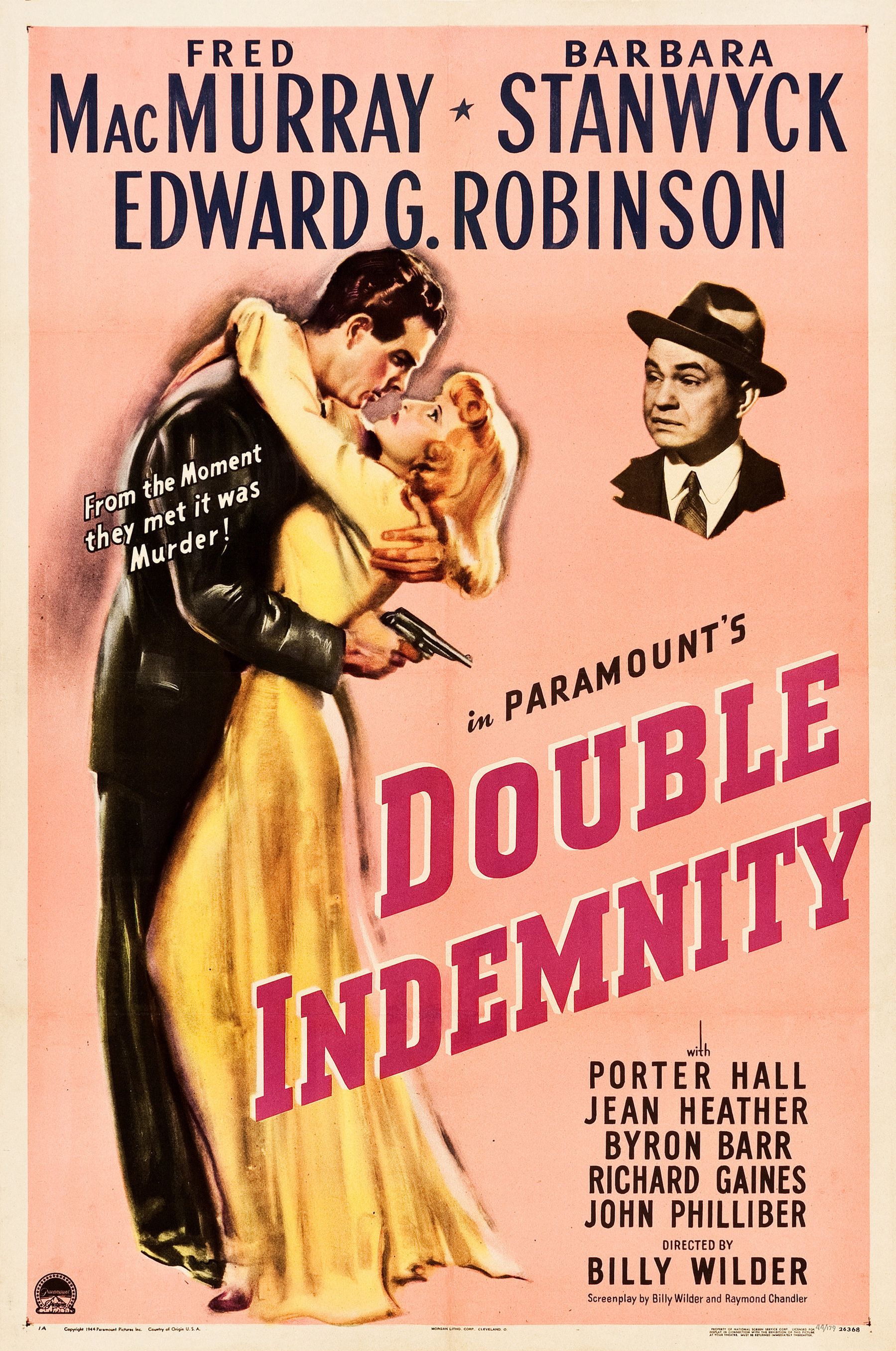
📺 We watched the final two episodes of "Succession." I have thoughts. SPOILERS
I’m seeing some talk that Tom isn’t the winner because he’s just Matsson’s puppet. But Tom is definitely the winner. All he ever cared about was the money, buying luxuries, and the appearance of power and he got all those things. He doesn’t care about the reality of power.
Tom will remain perfectly loyal to Matsson—until the moment Tom sees it as advantageous to throw his loyalty to someone else. Probably Matsson knows this, and sees Tom as a useful tool.
The same person who said Tom isn’t the winner also compared Tom dismissively to Gerri. That’s nuts. Gerri is one of the winners of “Succession.” She was Logan’s loyal consigliere and assassin for 30 years, and she cashed out big and walked away.
Justine Lupe, who played the high-end-callgirl-turned-wife Willa, also played Astrid Weissman, Midge’s sister-in-law on “The Marvelous Mrs. Maisel.” Her role on “Maisel” is extremely different from Willa. On “Maisel,” she’s a the perfect midcentury upper-middle-class American housewife and mother, a shikse who converted to Judaism to marry a Jewish man and is now more Jewish than her Jewish family.
I love the video playing in Conner‘s apartment, and the kids’ faces as they watched it. We saw another side of Logan there, away from the kids and relaxed, affectionate and warm. Frank, Gerri, Karl and Jess were Logan’s real family, the people he loved and who loved him. Kendall, Roman and Shiv were not part of that family, and they knew it. Connor, on the other hand, was part of that family.
The entire four-year “Succession” story could have been told from Frank and Karl’s perspective, and it would be a very different story.
Why did Shiv vote the way she did? I don’t think we ever get a definitive answer in the show, but I think it was because in the end she just couldn’t stand to see Kendall win. According to discussion on Reddit, there’s a scene just before the vote when Kendall puts his feet up on Logan’s desk, and you see a look of disgust cross Shiv’s face. Neither Julie nor I saw that.
As the CEO’s wife, Shiv is in a better position as Kendall’s sister. But I don’t think she was calculating it through that far until after Tom was named CEO.
Of course, Tom isn’t the real successor. Matsson is the successor.
Roman is finally out, and he is relieved. He never wanted the responsibility. He just wanted to pretend to be a playboy and now he’s back to that.
A theme that emerged throughout “Succession” is that the people who appear to be in power—Tom, the President of the United States—are not the people in power. The real people in power are the people who pay those other people: the Logans and Matssons. In “Succession” we spend a lot of two seasons focused on a Presidential election in which one of the candidates is a neo-Nazi, and it turns out to be a minor plot point, not worth resolving in the finale. Because that election just didn’t matter in the universe of “Succession.”
Shiv is the sort of woman misogynist who sees herself as the exception. She is not the exception. She has become her mother, and is married to a man who literally sits in her father’s chair.
I love the rare sweet moment at the end of the show where Logan’s wives and mistresses all came together as this little supportive sorority. Marcia even takes Kerry’s hand. They were all the women that Logan betrayed, and in the end they stood by each other. Although maybe not—in the universe of “Succession,” you never can assume love and decency is real.
Does Willa care about Connor after all? Or is she just in it for the money? Yes.
In the scene at the bar at the end, Roman orders Gerri’s favorite drink.
I don’t know if we actually enjoyed the final season of “Succession.” Watching it had become compulsive.
I kept expecting Roman’s dick pics to go viral on social media. They were Checkov’s dick pics, and they never were fired.
“Succession” creator Jesse Armstrong shares his view on where the characters go after the season finale: Tom isn’t just going to be an empty suit. He’s got a lot of hard work ahead of him. But he will never be anything other than Matsson’s dog.
Armstrong says Roman is back where he started; the whole multi-year arc was just a detour for him.
Armstrong: “Shiv is still in play … in a rather terrifying, frozen emotionally barren place.”
Also Armstrong: “For Kendall, this will never stop being the central event of his life, the central days of his life, central couple of years of his life… Maybe he could go on and start a company, or do a thing. But the chances of him achieving the sort of corporate status that his dad achieved are very low. And I think that will mark his whole life.”
Why does “Succession” get so much more journalism and social media love than “Yellowstone,” which has similar premises and themes and is far more popular among the viewing public? I think it’s because “Succession” centers on the media business and New York, and therefore has more appeal to journalists and the professional-managerial classes that dominate journalism and social media.
I’ve read that “Succession” is a blue show and “Yellowstone” is a red show, and there’s a lot of truth to that. But “Yellowstone” is more nuanced and ethically diverse and more broadly focused across class lines. Go figure.
In our house, we watch both “Succession” and “Yellowstone.”
We watched “Murder Mystery,” a 2019 comedy-mystery starring Adam Sandler and Jennifer Aniston as married couple Nick and Audrey Spitz, a New York cop, and a hairdresser. On a flight to Europe for a bus-tour vacation, she strikes up a friendship with a dapper gentleman on the plane. The dapper gentleman spontaneously invites the New Yorkers to join him for a celebration on his billionaire uncle’s yacht. On the yacht, someone is murdered, and the Spitzes are the prime suspects.
It is an oddly old-fashioned movie. The gags all depend on the premise that the Spitzes are amiable lower-class shmos in a world of elegant toffs. We’re at an Agatha Christie murder mystery on a yacht, but instead of Hercule Poirot, our heroes are Oscar Madison and Laverne from Laverne & Shirley. Even the names Nick and Audrey Spitz seem to echo Nick and Nora Charles. I particularly liked the wardrobes—Sandler in baggy cargo shorts surrounded by men and women in tailored evening wear, Aniston in her outfits from Target (not Marshalls—she’s very clear on that point!).
The movie clocks in at 97 minutes, the ideal length for a movie, and ends in a lovely car chase through European streets.
You will like this movie very much if this sounds like the kind of movie you’d like. It is, and we did. 🎥
I have friends who used to go see movies at random. They caught movies the first days the movies were released before they saw trailers or ads or reviews. They would go to a theater, buy a ticket, and see whatever was playing. One of these friends based decisions on movie posters, and solely the posters. Another would drive to the multiplex and see the next movie that was playing after he got out of the car.
Having just seen “John Wick” and “Everything Everywhere All At Once,” I get the appeal of that system. The first half hour of both of those movies are very different from what comes later, and it would have been a delightful surprise to see all that spool out without expectations.
The first half hour of “Everything Everywhere” looks like an arty family drama about a middle-aged woman who’s estranged from her daughter and husband and struggling to save the family business. No science fiction or fantastic elements at all.
In the first half hour or so of “John Wick,” you don’t know he’s a super-hitman. You first get an idea when John Leguizamo recognizes the car. We’ve already seen those Russian young men are extremely dangerous, but John Leguizamo is more afraid of John Wick than of the Russians. We don’t discover John Wick’s full story until Viggo confronts his son.
Back to “Everything Everywhere:” A great thing about that movie is that it really is primarily an arty family drama about a middle-aged woman who’s estranged from her daughter and husband and who is struggling to save the family business. The science fiction serves that story. Saving the multiple universes is the B-plot. 🎥
